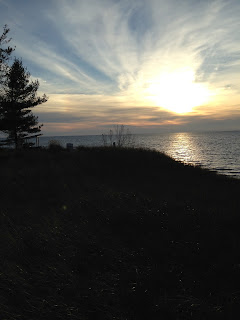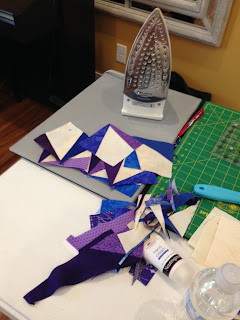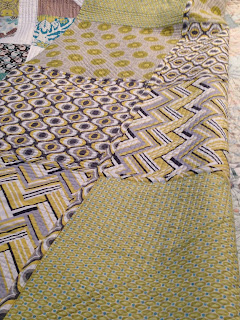It's very common now for the quilt bloggers offering a quilt as you go( QAYG )method. I have tried several methods, including the early method that keeps the back looking more traditional - one piece. My newest journey began watching my buddy Caroll D teach her class on QAYG ala
The Quilting Edge technique. I just started with this method wanting only the sash joining process. I did it on this quilt:
The other two tops from this BOM experimented with various sash widths. These quilts have added strips on the front and back by cutting batting strips to size and adding strips to cover.
The top selection has narrow strips whereas this quilt has wide strips. The back below worked out the best as I limited my choice of fabrics and thread choices.
Recently, I've had larger quilt tops to complete and really wanted to work the technique a bit. Larger batting strips are far easier to cut than 3/4" strips. It's a great way to use scraps but so annoying with 20 squares or more to connect. Traditional sashing of 2" would make the quilt larger than I wanted.
On my Beehive quilt, below, I wanted to play more and experiment with several things: stitches, fabrics and techniques. The top's connectors, using the seam allowance as batting, are attached with no top stitching, similar to how sashing is normally attached. On the back, however, only one edge can be attached from the underside. One side must be topstitched. In the original or "traditional" method taught, this edge of the strip is hand stitched. The traditional method doesn't have the long line of stitching showing, but wasn't going to hand stitch all these blocks. I used my machine, hoping to disguise the bobbin stitching-now on the right side- with overall quilting. Well, nothing is quite that simple in my world. The quilting on the top, in this case, involved decorative stitches around each of the circles. What to do with the somewhat, mostly straight line, now showing....use matching thread. It provides a border, of sorts, to the seams.


With the Circle Quilt narrow strips of 1 1/2' of a fabric were cut with both long edges pressed to the center. This strip was then placed over the space created by the topside's sashing strip. It worked ok, but the iron's steam was a bit too hot on the finger tips. Thus, the method I used below was devised.
Unlike the other quilts, this top had a very defined pattern and did not require any top sashing. Yeah! I quilted as I goed, QAYG, all three layers, in blocks of four. Each four patch was about 18". The quilting required more planning than I usually do. All in all the machine quilting was no more than one long row of four four patch blocks. The large squares I practiced free motion with my new machine - not so good, but the thread is hidden (learned that lesson finally). Now for the backside.
I alternated four fabrics behind the front's four patches. The connecting sashing matched one of the backings, as shown in these two pictures.
Since I used the seams allowances, 1/2" (two 1/4') as my batting, I just needed to add a strip. The picture below shows the strip topstitched.
While the strip may not be as smooth as other methods, I enjoyed this method, it met my emotional standard.
Here's how I made the strips:
Steam press the seams open and make them flat as possible.
Cut a strip long enough for your block 1 1/2' wide. Since I'm not as an exact sewer that I dream I am, I strive to make things to work. Sew the strip, wrong sides together with 1/4" seam allowance. While opening the tube by pressing the center, align it to the strip's edge as shown above.
With your flattened tube strip, trim the allowance down to 1/8". At first I left the 1/4" and threads from the edge peeked out . Yuck. The trimming moves the raw edge away from the topstitching edge.
With the right side of the strip up, lay it on top of your flatten seam allowance and top stitch close to each edge, to the end. (This strip is perpendicular to the seam it will cover for illustration purposes only.)
Here's a completed block also showing, look closely, that because of the pattern on the topside, this vertical stitching won't really conflict.
Lessons learned:
- QAYG will make the topside blocks smaller. I chose to space the vertical quilting the width of my walking foot. This pattern has considerable blank space and required something. The angle of the patterns also led to straight line quilting. The heavily quilted blocks differed in size with the less quilted blocks.
- If to do over? Space vertical lines further apart....this quilt is really heavy!
- Limit thread color choices. On the Circle Quilt I was changing thread colors endlessly since I was rotating three fabrics and the top had several background colors, too. I really think I wore out a seam ripper on that quilt. On the Star quilt I used either white or a lime green. Even then when applying strips, make sure the bobbin thread matches the top background fabrics....
- The smaller quilts, like the very top examples, work better for some one like me who reaches the need to be done....more than anything.
I hope this experience of experimenting helps you try QAYG in some method. Just Google QAYG and you'll have severals tutorials from which to choose.
In case you're looking for a fast quilt, this pattern by Amy Gibson of Hickory Dickory Dock, has it now on her
website. I purchased it as a Craftsy.com kit. In case you're wondering, I have a good amount of fabric left over. Not enough to make several other quilts, but enough that I think I'll go back to The Quilting Edge and try that method.....great for scraps of all sizes. The Craftsy.com kit was generous, but not too generous....just right.























































